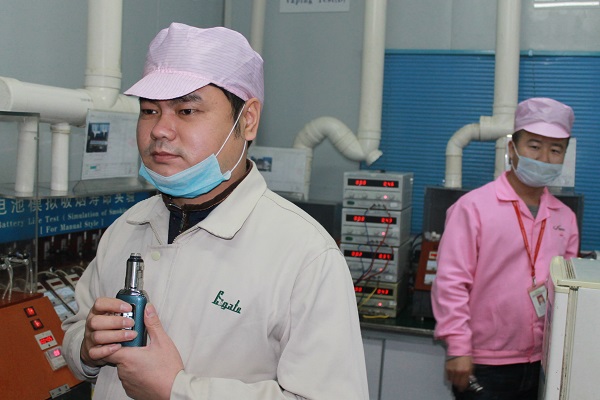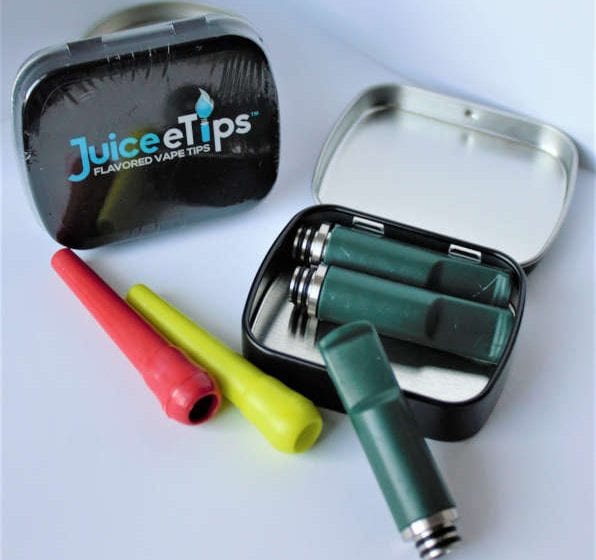The president and founder of Aspire, Tony Lau, has been making vapor safer for more than a decade.
By Timothy S. Donahue
Tony Lau has helped transform an industry. Today, his designs are used by nearly every vapor industry manufacturer in Shenzhen, China, the vapor hardware manufacturing capital of the world. Lau, president of Shenzen Eigate Technology Co., better known as Aspire, has been producing and improving vapor products since early 2007.
Before getting into the vapor industry, Lau was working for companies like Remington and building hair care products. He learned how factories were run and how to create proper quality-control (QC) protocols. In 2007, Lau began his vapor career with KangerTech, long considered to be one of the oldest hardware manufacturers, as one of KangerTech’s four original owners. At KangerTech, he brought his expertise in QC, R&D and production to the new industry. Speaking to Vapor Voice through a translator during a recent visit to Shenzhen, Lau says he saw the e-cigarette industry as a way to help people quit smoking and start using nicotine in a safer format.
During the early years, Lau was producing batteries for some of the first e-cigarettes on the market. He began to confront then-industrywide issues like leakage and spitback and wanted to try to do things his own way. In 2010, Lau left KangerTech to open his own company, Eigate. The company was finding early success and was growing quickly. In 2013, Eigate started its own brand, Aspire, according to Lau. At Aspire, Lau is in charge of QC and R&D. His nephew Allen Lau oversees sales, marketing and production. “This is so I can focus on R&D and QC,” says Tony Lau.
In 2015, Aspire had more than 600 employees and about 6,000 square meters of factory and office space. Today, the company employs over 1,000 people and has 15,000 square meters of factory, office and lab space that is good manufacturing practice (GMP) and ISO 9001 certified. “None of this has been accomplished by chance. Aspire has a professional product R&D team as well as a strict quality-control system to ensure [the] best in product quality, and we are not doing it alone. Aspire constantly works with overseas designers and researchers to develop new products that bring users the best and most healthy alternatives to tobacco,” says Lau.
Aspire has put continuous effort into establishing close and stable relationships with its distributors by promoting mutual cooperation. With the help of its distributors, Aspire has created service centers worldwide to provide customers with quick and efficient support, according to Lau. “With the efforts and creativity of the Aspire team, we have quickly become one of the leading brands in the vaping industry,” he says.
In the beginning, Lau was creating devices but didn’t understand how the hardware was interacting with the user, so he started vaping. He then began to realize that he needed to understand the transition from smoking to vaping and started smoking cigarettes to experience the difference firsthand. “I needed to understand customer feedback—airflow and flavor. It was the only way to know,” he says. “It’s not good for my health, but it has been good for many other people’s health. I hope what we are doing is making people healthier than [when they are] smoking cigarettes.”
When Lau began building the Aspire brand, his goal was to produce high-quality products that lasted for a long time. Today, Lau holds more than 1,000 patents around the world, most of them for designs in tank technology. “Now, almost all factories use technology that I created. We have patents in the U.S., Europe and China,” he says, adding that many people ask him why he doesn’t sue over other companies using his designs. “Because vapor is a new industry, and I want more people to come into the industry to help build better businesses,” he says. “The industry needs competition in order to have growth and longevity.”
One of the first products Lau created that changed the market was the CE4 tank with KangerTech. The CE4 was the first clear cartomizer (clearomizer) that gave consumers the ability to see how much liquid was left in the tank. “This was an important innovation,” says Lau. “It allowed consumers to save money by knowing when a tank was actually finished.”
The second generation of the CE4 allowed consumers to refill the tank. This was another industry first at the time. Sales exploded. The customer feedback started pouring in, says Lau. Now consumers were asking for variable voltage and wanted to be able to change the coil instead of just throwing away tanks when the coil was no longer producing the proper flavor. Lau started Eigate and Aspire to meet this demand, eventually creating the Nautilus, which was the first tank with a changeable coil.
Aspire’s Nautilus series along with the BVC coils changed the way vapers vaped by allowing adjustable airflow for the first time. Even today, the Nautilus tank and Nautilus mini tank continue to be very popular among vapers worldwide. “Now all tanks use this technology,” says Lau. “A company may change the appearance, material or shape, but the technology is the same.”
The vapor industry was starting to explode in 2014. That was the year that rebuildable dripping atomizers (RDA) became all the rage. The RDA could create some very big clouds. Lau refused to make an RDA tank. He knew there had to be a better way than rebuilding coils to get high vapor production. In 2014, Aspire rocked the vapor world again with the launch of the first device dedicated to sub-ohm vaping, the Atlantis series.
“With an RDA, users would have to fill the liquid many times, yet with Atlantis they could get more life from their juice, and it didn’t leak like most RDA tanks,” he says. “The Atlantis is much easier to change the coil—just replace not rebuild. The Atlantis tank helped spur the surge in e-liquid manufacturers because it made vaping easier.”
Lau wasn’t done changing the industry just yet. In 2016, the company launched Cleito tanks, which are refilled using the top fill design and use a revolutionary new coil design that frees up even more restriction in the airflow by eliminating the need for a static chimney within the tank itself. “The Cleito tanks have made vaping so much easier with [their] simplicity of design and high performance,” says Lau.
Then, in late 2017, Aspire and Lau released the revolutionary Revvo tank with the Aspire Radial Coil (ARC). The flat stovetop-like design provided an expanded flavor profile and increased vapor production. “This was another industry-changing design,” says Lau.
Now the industry is changing again. Sales for the “big vape” devices are plummeting, and consumers want the Juul-style pod systems, according to Lau. The marijuana, THC and cannabidiol (CBD) markets are starting to skyrocket as well. “We are now making the devices for this new THC/CBD industry. We are working on making the best devices for this industry and could be done as early as mid-July,” says Lau. “People may not realize that these different devices need different technology. The different oils have a different thickness and viscosity. For the consumer, taste is the most important thing, and you must make products that enhance the flavor of the oils.”
For a vapor company to be successful, Lau says that first and foremost it must produce high-quality products and test products for quality throughout the whole production process. Companies must also remember that battery cell life is vital to how long a piece of hardware will last. Therefore, Lau opened his own battery production facility.
“The best way to guarantee high-quality batteries is to produce them yourself, so that is what we did. In hardware, the customer experience is about the flavor; the second thing is the airflow; third is no leakage or spitback; and lastly, the product must have a long lifespan,” says Lau. “Aspire listens to its customers, and we want to bring consumers the cutting-edge products they want as well as provide outstanding service. That’s how we ‘Aspire’ to do business every day.”







